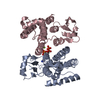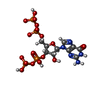+Search query
-Structure paper
| Title | Structural Basis for Virulence Activation of Francisella tularensis. |
|---|---|
| Journal, issue, pages | Mol Cell, Vol. 81, Issue 1, Page 139-152.e10, Year 2021 |
| Publish date | Jan 7, 2021 |
 Authors Authors | Brady A Travis / Kathryn M Ramsey / Samantha M Prezioso / Thomas Tallo / Jamie M Wandzilak / Allen Hsu / Mario Borgnia / Alberto Bartesaghi / Simon L Dove / Richard G Brennan / Maria A Schumacher /  |
| PubMed Abstract | The bacterium Francisella tularensis (Ft) is one of the most infectious agents known. Ft virulence is controlled by a unique combination of transcription regulators: the MglA-SspA heterodimer, PigR, ...The bacterium Francisella tularensis (Ft) is one of the most infectious agents known. Ft virulence is controlled by a unique combination of transcription regulators: the MglA-SspA heterodimer, PigR, and the stress signal, ppGpp. MglA-SspA assembles with the σ-associated RNAP holoenzyme (RNAPσ), forming a virulence-specialized polymerase. These factors activate Francisella pathogenicity island (FPI) gene expression, which is required for virulence, but the mechanism is unknown. Here we report FtRNAPσ-promoter-DNA, FtRNAPσ-(MglA-SspA)-promoter DNA, and FtRNAPσ-(MglA-SspA)-ppGpp-PigR-promoter DNA cryo-EM structures. Structural and genetic analyses show MglA-SspA facilitates σ binding to DNA to regulate virulence and virulence-enhancing genes. Our Escherichia coli RNAPσhomodimeric EcSspA structure suggests this is a general SspA-transcription regulation mechanism. Strikingly, our FtRNAPσ-(MglA-SspA)-ppGpp-PigR-DNA structure reveals ppGpp binding to MglA-SspA tethers PigR to promoters. PigR in turn recruits FtRNAP αCTDs to DNA UP elements. Thus, these studies unveil a unique mechanism for Ft pathogenesis involving a virulence-specialized RNAP that employs two (MglA-SspA)-based strategies to activate virulence genes. |
 External links External links |  Mol Cell / Mol Cell /  PubMed:33217319 / PubMed:33217319 /  PubMed Central PubMed Central |
| Methods | EM (single particle) / X-ray diffraction |
| Resolution | 2.95 - 4.43 Å |
| Structure data | EMDB-21850, PDB-6wmp: EMDB-21851, PDB-6wmr: EMDB-21852, PDB-6wmt: EMDB-21853, PDB-6wmu:  PDB-6weg: |
| Chemicals |  ChemComp-MG:  ChemComp-G4P:  ChemComp-ZN: |
| Source |
|
 Keywords Keywords |  TRANSCRIPTION / TRANSCRIPTION /  Francisella tularensis / Francisella tularensis /  bioweapon / MglA-SspA / bioweapon / MglA-SspA /  PigR / ppGpp / PigR / ppGpp /  RNA polymerase complex RNA polymerase complex |
 Movie
Movie Controller
Controller Structure viewers
Structure viewers About Yorodumi Papers
About Yorodumi Papers












